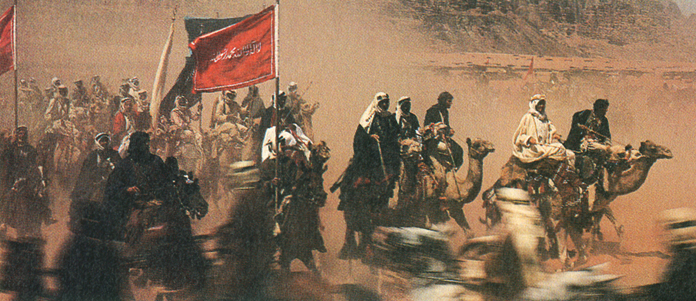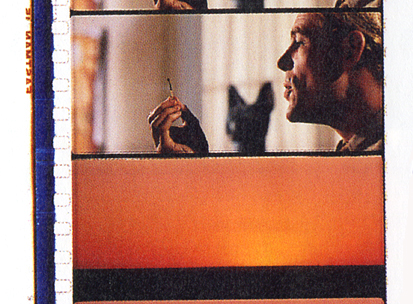RESTORATION // Robert Harris |
Restoration Artist
|  |
|
Robert Harris of Images Film Archive has overseen (with fellow producer Jim Katz) the theatrical restorations of such time-honored films as LAWRENCE OF ARABIA, SPARTACUS, MY FAIR LADY and VERTIGO. In this interview from December of 1992, Harris discusses the kinds of corporate, technical and emotional pressures that can sink or steer the effective rescue of our film heritage. Our discussion began with an exploration of the actual work involved in recreating a film's soundtrack.
Morgan: When you are restoring a film and are working with the score, original tracks, how often does it occur that a composer can come in and give his input as to how the restoration should take place? Harris: It obviously depends on if you have the composer. On LAWRENCE we were lucky enough to have Maurice Jarre; in the case of SPARTACUS Alex North was already quite ill, and although we would have loved to have had him in the loop, we made sure that Bob Lawrence who had worked with him — Bob was the editor — kept him up to date on everything. We wanted to make him feel involved and appreciated, and hopefully we did. One of the things that we do when we do a restoration is try to involve the people that made the film originally, and if they have not survived, their family members. The work that was done on these films was extraordinary, just the amount of craftsmanship, and I think that should pass down from generation to generation as far as involvement. As far as LAWRENCE, we didn't have music tracks; they had been junked in the `70s by the studio. So they had to be re-recorded? Well, let's define "re-recorded." Performed again? No. What we had to work from were combined stereo tracks, M&E and D (music/effects and dialogue), and then we had an M&E track for the foreign version — everything without the dialogue. And what I did in some situations, for example where we would be missing some music, I would try and go in to the M&Es and steal it from somewhere else in the film. A perfect example would be the intermission music; it's actually the music that's played under the sand dunes the first time. So we were able to take it from that and change it and clean it up. LAWRENCE was a 3-track mix, L-C-R (left-center-right front channels). In a few situations there was an effects track in the rear, it really wasn't a surround. What we did was to spread it by creating a surround channel to give it a little more atmosphere, especially as the music builds, so that it can move through the theatre, and we also added low frequency information on channels 2 and 4. The "boom tracks." Yeah. On SPARTACUS the film was recorded in 6-channel discrete sound, and we had all of the original music tracks; Universal is extraordinary at saving their materials, I have to give them credit. The vaults when we were there were run by Ed Zier, now run by Robert O'Neil; the vaults at Universal and (I think I should really make a point of this) the vault people at Universal — because your whole system and your vaults are nothing without your vault people — are beyond peer, anywhere. They are extraordinary. Every can, every separate can has its own bar code and its own place and its own computer allocation. When they introduced computers into their cataloging they must have had to go through every single can to check it and catalog it. Yes. During that process, did they uncover any previously-thought "lost" films or footage?
So therefore it didn't exist? It didn't exist! We found 3 or 4 quarter-inch tapes of original SPARTACUS sessions and we dropped them on his desk and his jaw dropped open. In SPARTACUS which was a 6-track discreet mix, we actually remixed it, cleaned it up and did all the new sound; 4 (L-C-R plus surround) & baby booms, and 6-track discreet the same time, because I thought that it should survive as six-track discreet. What are the chances of pre-mix materials surviving for a film more than, say, 10 years old, so that if you had to go back to re-dub or matrix into Dolby Stereo you would not be left with the final sound levels and edits that presently exist on the master? It depends on the studio. At Universal, [chances are] pretty damn good. I think if you went into Universal's vaults you'd find things where you'd say, why did they keep them? But I think they'd rather keep them and then five years down the line say, all right, we haven't used them in 15 years, now let's get rid of them, rather than be caught with their pants down. There were some studios that were notorious for trashing things because they lacked the foresight. Well, for example, there's Fox, which is pretty much near the bottom of the barrel, and UA but they weren't a studio. The MO at Fox was to do their final 4-track mix for their CinemaScope pictures, at which time they would make their stereo release prints, sound their stereo (mag) prints from the original master, and then degausse it because clean mag stock was hard to get. So all that exists are any surviving mag prints? That's correct. I spent a week in London going through the vaults, going through BRIDGE ON THE RIVER KWAI materials. Was that a stereo film? I've seen it indicated as such in some references but it's not available in that format. There's controversy about that. There are collectors out there — and I think very highly of collectors — who say they have prints in stereo but aren't going to show them to me! And that kind of raises major questions in my mind. I listened to a lot of the original music mix tracks and they're mono. [And] there was print-through on them. * *KWAI was recently issued on laserdisc with a newly created stereo soundtrack, allegedly based on pre-existing elements that were located and pulled together.
There are two types of restorations going on: restoration goes on daily at the studios, at least most of them. It's the oddball restorations that I do, the ones where you can't work for the studio and do something else at the same time. When I do a restoration, that is literally 100 percent of my waking (and some of my sleeping) hours. You know, three o'clcock in the morning I'll figure out where to find a certain piece of a film in the vaults that I'm looking for to fill something in. I'll give you a perfect example. In SPARTACUS, the scene after the slaughter of the slaves, Reel 21, if you look at the version that's been out for years you have Olivier and the other actor walking [past] a stone and the camera moves over the bodies of people, it's called the River of Blood — we extended that by about 20, 25 seconds. And in the original notes I had found there was a black opera singer named Shirley Verret who had sung an elegy, a very, very depressing human voice, over the bodies of the dead. No one can find it, no one knew what happened to it. There were also some baby cries, things of that sort. When you research this material, I found out that the last preview cut of the film was 28 reels rather than 26. And although we had listened to all of the older surviving reels from the pre-mix (and there were only half a dozen of them), there were a few that I didn't listen to because they were the wrong reel numbers. I woke up three o'clock one morning and basically said to myself, 'You idiot, if you're looking for material for reel 19 or 20, what you want to do is look five, six minutes later in the film — you should be looking for Reel 22 or 23.' And we pulled it and there she was. And that's why the studios can't do it; you take someone who's working on 20 different projects (which basically means sending orders to the laboratories) and have them looking for these little bits and pieces, to try and do something perfectly? Are the studios making plans to hire staff whose primary function would be to save their most noteworthy films and restore those? I don't think so. I don't think that they can. Besides getting someone like myself or Kevin Brownlow or Ron Haver, you know, an individual who is attuned and knowledgeable in this field, because I'll be perfectly honest with you, it is so painful an experience, and it takes so much out of you and it takes so long, that unless you're absolutely passionate about the film, they can't pay you enough. LAWRENCE was 26 months; SPARTACUS was 14 months. But we had a lot of problems because we were combining in sound elements, the original magnetic mix, the final mix, new dialog combined with music that we'd stolen from other parts of the picture where we needed to, new dialogue that was not combined with music but was combined with effects, and a dub that was spread from duped optical soundtrack that had a little bit of hiss to it, when you try to take out the hiss you lose the top end. So what I ended up doing was degrading all of the sound around it. If you listen to the tracks carefully, where we go to a sequence where we only had optical [sources], starting about a minute before we bring up very, very slowly an optical hiss loop that we created. So it isn't jarring to go from no-hiss to hiss. So it isn't jarring at all. And we used the same loop to go out of it. So we actually degraded parts in order to make it less obvious. Because the end result has to be something that people can go to see and enjoy and not think of as a 'restoration.' If you start thinking of it as a 'restoration,' then you lose the magic. One of the top people in Columbia's legal department turned to me after the film and said, 'I don't see where you've done anything to it, I don't see where you've added anything.' And I said, 'Thank you, that's the trick — you're not supposed to.' 
Was there documentation about LAWRENCE's recording sessions? No, we had what we had, and we had to work around it. It was very difficult sometimes. The scene where Allenby and Lawrence are triumphantly walking down the stairs talking about military matters before they go into the courtyard, I added bits of dialogue in there. There were three or four shots added, so we had to junk the entire musical track and go back and go to M&Es and extend it and get tracks from other sources, wherever we could find it, to bring this particular bit of music back to the point before the cues were cut up and junked. We added 10 or 12 seconds. When we opened in L.A., I warned Maurice that he was going to hear a seventh-generation print. You could see his whole persona drop when he heard that! One of the things that I do try to do is stay true to the original mix. In LAWRENCE when the music comes up it comes way up, and there are some people who object to it — I happen to think it's great. That's exactly as it was. You have to be willing to try anything, you have to be open-minded, and the bottom line really is you want to make it the most pleasurable movie-going experience you can, and not a textbook restoration. How are they storing elements of today's features? Well, they're doing not digital disks but they're certainly keeping 24 tracks and things of that sort. I don't think we'd ever see anything like the music tracks of LAWRENCE being junked again, I mean that to me is the most unconscionable thing that's ever occurred. How do you take Maurice Jarre's work for a film like that and say, 'Well, we don't need it anymore, let's burn it'?!? I found a lot of stereo tracks that they didn't know were stereo in London, along with the stereo tracks of ANASTASIA, a Fox picture, which was in their vault. Most of them are pretty screwed up and they have a lot of people there who know nothing about film, nothing about film history, and it's really unfortunate. And if you don't know film, if you don't know film history, if you don't care about film, you can't restore film, because how do you know what to reject, how do you know what it's supposed to look like? What scenes are supposed to be day-for-night? What about films that probably wouldn't be found in studio vaults, because they were independent productions, or have gone into the public domain? There are a lot of films that are orphans, like DUEL IN THE SUN, which is owned by ABC. Or THE LION IN WINTER, which is owned by this French company, who we've been working with for the last year or two to allow us to save their film which their technical people tell them is fine. I will give you, cash, a million dollars if you can make a print of LION IN WINTER from the original negative this week. If the problem is primarily duplicating picture and sound materials before they degrade, how much would it cost the studios to preserve an average film? Tens of thousands. The majority of those can be done in-house on a daily routine basis. There's really no problem with that. Universal does it all the time, Warner is doing a lot of it now. Turner does a lot of it. What is your opinion of Turner's efforts in colorizing black-and-white films? As far as I'm concerned they can do whatever they want to, because they are doing preservation elements. They are doing more than most of the studios. And he didn't even make the bloody pictures! But he sees the value in them. Oh yeah. They put a lot of money into that. For proper preservation to be done [of their archives], each studio would probably have to spend, I'd say, 40 to 50 million dollars each. Do they factor the costs of preserving elements into the post-production budgets of each picture?
The worst thing and the reason I tend to go for the large-format films, the epics, is that they are the most endangered. Because during that period, the duping materials weren't good enough to make an interpositive and then an internegative and then a print; consequently every single 70mm print, every set of matrices (which means three runs off the negative for each set of matrices), every interpositive were all made off the camera negative. The LAWRENCE negative was run over 220 times. And cut and then re-cut again, it was cut three times, there were dupe sections in it when I got it, it was horrible, it was shot. The last four months of the project in May we had the screening for the studio, the next day I started putting some final fixes into it, and then I ordered an interpositive and that's when the negative died. Literally died — the perforations started cracking, the emulsions started cracking, it was 27 years old, at the very end of its life, over-printed, and it started falling part, every splice started opening. And you're printing at 150 feet per minute so every morning around seven o'clock I'd get a call at my hotel to tell me what reels broke up the night before. Postscript: Harris has since worked to restore several other classics, including including Alfred Hitchcock's REAR WINDOW and VERTIGO, the 70mm MY FAIR LADY, and THE GODFATHER TRILOGY. He is presently working on a restoration of the John Wayne-directed THE ALAMO. |
copyright 1992, 2009 by David Morgan
All rights reserved.









 Well, they're making separations — not necessarily
testing the separations so it doesn't really matter that they're making
them. It's rather like climbing a mountain. You can put rope through the
ring, but they're climbing mountains with frayed ropes. It's a big, big
problem.
Well, they're making separations — not necessarily
testing the separations so it doesn't really matter that they're making
them. It's rather like climbing a mountain. You can put rope through the
ring, but they're climbing mountains with frayed ropes. It's a big, big
problem.